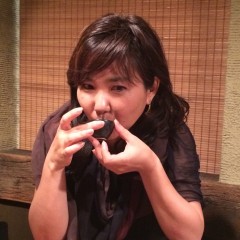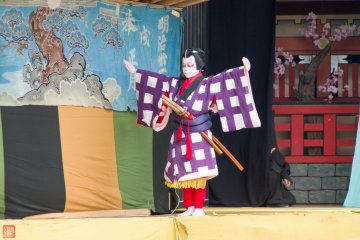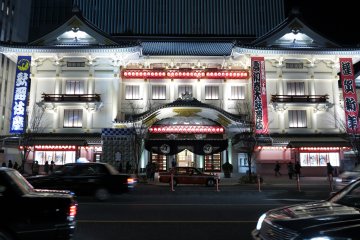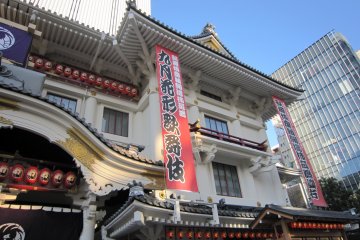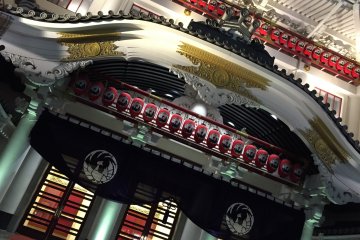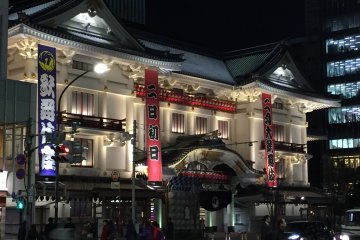My first foray into Kabuki-za was a decade ago, and it was completely unmemorable. I was taking a friend on a stopover to India around Ginza aimlessly, and though neither of us were theater fans, we decided to see one act of the show since it was cheap. More of an incentive was a desire to get out of the hot sun. We had no idea what the stories were about, and readily accepted the English audio guide. Waiting in the lobby until the next intermission, we actually became excited, trying to decipher the cryptically English translated leaflet they gave us. We didn't have seats together, which we didn't mind as much as the fact that we both had rotten views. The static of the audio guide felt like an alien brainwash and I took it off before my migraine got worse. Peering over at my jet-lagged friend, she was clearly asleep or completely overtaken by the alien sound waves. For the price of a cappuccino, we got to rest our tired feet and my friend enjoyed her much needed nap. Also we got to spend time in Kabuki-za! However truth be told, I adore a good chat over gourmet coffee, so it would be years before I would venture into the hallowed halls of Japan’s most famous theater again.
Once in a while, I would catch a television documentary on the lives of famous Kabuki actors and I gradually became open to the idea of going to see a show again. This time it would be for the full show and I would actually know the plot. I waited another decade hoping someone would invite me to see a show. Finally, it was me who forked out over ¥20,000 per ticket to buy the best seat category. Unlike the cheap ones, we could hear the twang of the string instruments being plucked, marvel at the spectacular colors of the embroidered kimono, and watch the subtle expressions of the actors change. It was a favorite relative’s 70th birthday and she had done me countless favors through the years so this would be a lump sum display of gratitude. Our plan was to have lunch in Ginza before the matinee show, where she would give me a detailed explanation of the stories we would be seeing. That plan was foiled when she missed her train. Instead, I bought us lunch boxes – a two-decker colorful assorted one for her, one with sushi balls and beef cutlet sandwiches, a Higashi Ginza specialty, for myself. Boy, everything was all delicious! We remained in our seats during intermission to eat and she updated me on the plot. For our show, it would be a classic tale of Chushingura, based on the true story of which the 47 Ronin. It ended up being one of the most memorable experiences of my twenty-plus years in Japan. However, I am in no way a convert to Kabuki. Actually, I’m back to hoping that someone will invite me along. Only now, much more eagerly than before!
My non-expert advice to enjoying Kabuki-za:
-
Buy tickets early:
As with any show, the earlier you buy the tickets, the better your seats will be in the same price category. If at all possible, go on the first day of a new show and soak in the glamour of the regulars wearing their finest kimonos. -
Ask Japanese friends for plot information:
The information they provide on their website is lame. There may be better resources, though Googling didn’t provide me with much more than some academic babble. Instead, ask Japanese friends. Recently I asked a long-time English student what she watched on cable and she said “Kabuki!” She then spoke at length about her favorite stories. I should have paid her for that lesson. -
Buy a bento and blings.
Take the escalator to the right side of the theater to enter the shopping arcade. Buy one of the specialty lunch boxes to eat during intermission. There is a full array of trinkets including customized good luck charms made by hand. The arcade connected to Higashi Ginza station is easily one of the best places to buy souvenirs and bento lunch boxes. -
Go inside early and soak up the atmosphere.
Be aware that there are Kabuki shows at other theaters besides Kabuki-za, but even if you are not a dedicated fan, why miss the opportunity to go inside the gorgeous iconic building? -
Do not use the English audio guidance.
Trying to listen to the translation using headphones will just distract and take away from the experience of enjoying live theater. Put away that monocle. Just watch and listen.


